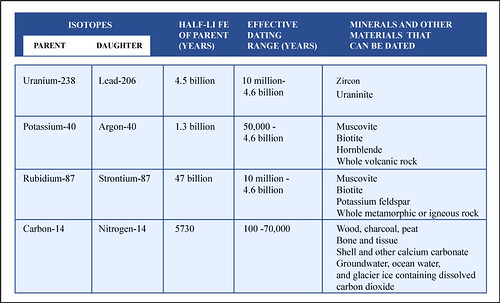Geological time scales help us to know the age of formations and three types of time scales are relative, absolute time and magnetic polarity scales. Relative time scale relates to an order in which a specific rock sequence occurs, but absolute time is an actual time that is derived from the chemical half-life of minerals in rocks. Magnetic polarity uses a concept of magnetic sequences to age the rocks.
Image may be NSFW.
Clik here to view.
Relative Time Scale
Relative time scale started in the nineteenth century when geologists in Europe began to put together fossil records to see which one happened before or after another one. At that time, the geologists did not have a way to determine absolute time. Before the development of radioactive dating, geologists used a simple way to roughly estimate sedimentary rock ages. For example, 1 km of sedimentary rock with 0.1 mm of accumulation per year: the estimated age of the sedimentary rock is 1 million years.
The relative time scale expresses in term of interval of relative time, like which rock comes first by studying about relationships between layers of sedimentary rocks and three important concepts of relative dating are as follows;
Biostratigraphy – Fossils in a rock bed are utilized to determine relative ages to other sedimentary planes.
Lay of original horizontality – Sediments laid by water are laid in horizontal or near horizontal plan.
Law of superposition – An older layer of rock lays beneath a younger rock bed.
These three concepts widely used to map layers of rocks which have a similar lithology and physical appearance, but there are some concerns about them. Firstly, typical sediments are not laid at uniform rate. Secondly, how many years have passed depositional periods which cannot be determined and finally, it is impossible to know the relative age of two similar rocks that are separated widely across beds.
Law of faunal succession is a law in geology that is about assemblages of fossil plants and animals that follow or succeed each other by a predictable time. This law is very important in stratigraphy because individual fossils can represent a relative timescale when geologists use each fossil to compare relative rock age. In petroleum exploration, it is common to use microscopic fossils or spores and pollen from plants to estimate the relative time of formations. Figure 1 illustrates the geological timescale.
Image may be NSFW.
Clik here to view.
Figure 1 – Geological Time Scale
Absolute Time
Using relative time cannot give the exact date because there are several uncertainties and flaws in assumptions. Radioactive sources were discovered in 1896 and were introduced to use in determining age of rock in 1905 by Earnest Ruthford. The concept of the radioactive method is to utilize the radioactivity level in rocks to calculate the age of each rock. Unstable radioactive isotopes decay into stable isotopes over their half life. Potassium 40 (parent isotope), for instant, will decay to Argon 40 (daughter isotope) in about 1.3 billion years and its effective dating range is between 50,000 – 4.6 billion years. Table 1 shows major isotopes used in radiometric dating.
Table 1 – Major Elements Used in Radiometric Dating
Image may be NSFW.
Clik here to view.
Absolute geological time given from the radiometric dating method is often integrated into relative geologic time (Figure 1) to help users understand the timing of the relative time scale. Please remember that these dates can be changed depending upon updated information.
One example of radiometric dating is to determine the age of the Earth. The oldest sedimentary rock based on radioactive material is 4.1 billion years old, so it can be implied that the Earth must have been formed before 4.1 billion years ago
Magnetic Polarity Time Scale
The direction of magnetic polarity of the Earth is recorded in hot lava when it becomes solid and then crystal after the cooling process. This will create magnetic sequences on either side of diverging faults. Magnetic polarity can be reversed from normal polarity several times, so it is a very a very useful way to date rocks. A period of normal polarity and reverse polarity is termed as magnetic chrons.
If sedimentary rocks have magnetite material, it will have it owns magnetic direction. The magnetite material will align its particles naturally with the Earth’s magnetic field when the sediments settle. Thus, the sedimentary rocks will have a low magnetic alignment. Only magnetic reversal cannot be utilized alone to date the rocks because another reversal magnetic can have the same look. It is imperative to discover a continuous sequence and use this information along with other sources of dating information as fossil records to determine the precise age of formation.
References
Richard C. Selley, 2014. Elements of Petroleum Geology, Third Edition. 3 Edition. Academic Press.
Richard C. Selley, 1997. Elements of Petroleum Geology, Second Edition. 2 Edition. Academic Press.
http://www.kgs.ku.edu/, (2015), Geological Time Scale [ONLINE]. Available at:http://www.kgs.ku.edu/Extension/gifs/color_time_scale_2013.png [Accessed 26 October 15].
Summons, Roger, (2007), Major Elements Used in Radiometric Dating [ONLINE]. Available at:http://c2.staticflickr.com/4/3566/3588634881_a0cefbe601_z.jpg [Accessed 21 October 15]